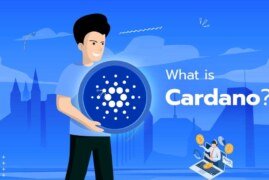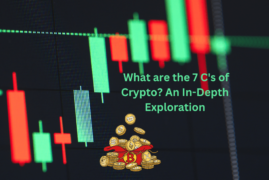In the ever-evolving landscape of the digital world, a new era is dawning—the era of Web3. If you’ve heard whispers of this technological revolution but aren’t quite sure what it entails, you’ve come to the right place. In this blog post, we’ll embark on a journey to unravel the mysteries of Web3, exploring its roots, its components, and its promise for a decentralized and user-centric internet.

Imagine an internet where central authorities no longer wield the power to control information, where your data is truly yours, and where trust is embedded in the very fabric of the digital realm. This is the vision of Web3, a groundbreaking concept that marks the next chapter in the internet’s evolution.
In Web3, the internet isn’t just a network of interconnected devices; it’s a network of trust. It builds upon the foundation of decentralization, blockchain technology, and a commitment to privacy and security. But before we delve deeper into its intricacies, let’s rewind and understand how we got here.
2. The Evolution of the Internet
Web 1.0 to Web 2.0: A Brief Recap
The internet’s journey began with Web 1.0—a static realm where information was one-way and read-only. It was the age of simple web pages and limited user interaction. Then came Web 2.0, a dynamic shift towards interactivity and user-generated content. Social media platforms, blogs, and collaborative tools proliferated. However, Web 2.0 brought its own set of challenges, including data centralization, privacy concerns, and dependence on intermediaries.
3. Web3 Foundations
Foundational Technologies
Web3 is not a mere iteration; it’s a paradigm shift built upon innovative technologies:
Blockchain Technology: At the core of Web3 is blockchain, a distributed and immutable ledger. It provides the foundation for trust and security in the digital realm. Each transaction, interaction, or piece of data is recorded in a tamper-resistant manner, reducing the need for centralized authorities.
Decentralized Networks: In Web3, networks are decentralized, meaning they aren’t controlled by a single entity. Instead, they rely on a network of nodes, each contributing to the network’s security and functionality.
Cryptocurrencies: Digital currencies like Bitcoin and Ethereum are key components of Web3. They enable peer-to-peer transactions and innovative economic models within the ecosystem.
Tokenomics and Cryptoeconomics: Expanding on this, let’s dive deeper into how tokenomics and cryptoeconomics are driving innovation within Web3. Tokenomics involves the study of how tokens or cryptocurrencies function within a blockchain ecosystem. It explores their utility, distribution, and economic incentives. Cryptoeconomics, on the other hand, studies the economic and game-theoretic incentives in blockchain networks. It’s a fascinating blend of cryptography and economics that ensures network security and aligns incentives among participants.
4. Blockchain Technology
Blockchain Basics
Blockchain, often referred to as the “backbone of Web3,” is a distributed ledger technology. It operates on a decentralized network of computers, ensuring that no single entity has control over the entire system.
Security and Transparency: One of blockchain’s primary advantages is its enhanced security. Once data is added to the blockchain, it becomes virtually impossible to alter or delete. This immutability is crucial for ensuring trust in Web3 applications.
Decentralized Applications (dApps): Expanding on the concept of dApps, let’s explore how they are developed and used within the Web3 ecosystem. dApps are built on blockchain platforms and follow a set of protocols that make them decentralized, tamper-proof, and transparent. Developers use smart contracts to define the rules and logic of these applications, enabling trustless interactions between users. Examples of dApps span a wide range of domains, from decentralized finance (DeFi) platforms like Uniswap and Compound to NFT marketplaces like OpenSea. Each dApp serves a unique purpose and leverages blockchain technology to provide secure, censorship-resistant services.
5. Web3 Components
Essential Components
Web3 comprises several key components that contribute to its decentralized nature:
Decentralized Identity Systems (DIDs): These systems allow individuals to have control over their online identities, reducing reliance on centralized identity providers.
Smart Contracts: Smart contracts are self-executing agreements with the terms directly written into code. They automate processes and reduce the need for intermediaries.
Decentralized Storage: Web3 leverages decentralized storage solutions, ensuring that data isn’t stored on a single server, reducing the risk of data breaches.
Interoperability and Standards: Let’s dive deeper into the importance of interoperability and emerging standards within the Web3 ecosystem. Interoperability is the ability of different blockchain networks to communicate and interact seamlessly. It ensures that users can move assets and data across different platforms without friction. Emerging standards like Web3.js, which facilitates interaction with various blockchains, and Ethereum Name Service (ENS), which simplifies blockchain domain names, play a pivotal role in achieving this interoperability.
6. Tokenomics and Cryptoeconomics
Token Economy
Cryptocurrencies and tokens play a pivotal role in Web3’s economic model. Tokens often represent ownership in a project, access to a service, or voting rights within a decentralized network.
Incentive Mechanisms: Cryptoeconomics incentivizes users to participate in the Web3 ecosystem. For instance, users may be rewarded with tokens for providing computing power or verifying transactions on a blockchain.
Governance and DAOs: Expanding on governance within Web3, let’s explore how decentralized autonomous organizations (DAOs) work. DAOs are organizations represented by code, and their decisions are made by token holders through voting. This innovative model ensures community-driven governance and allows users to have a direct say in the direction of a project or platform.
7. Privacy and Security in Web3
Privacy Features
Privacy is a fundamental aspect of Web3, with technologies like zero-knowledge proofs and privacy-focused blockchains enhancing user anonymity.
Security Advantages: Web3 enhances security by eliminating single points of failure and reducing the risk of data breaches. Transactions are secured through cryptographic methods.
Challenges and Innovations: While Web3 prioritizes privacy and security, it’s important to acknowledge the challenges and ongoing innovations in these areas. Privacy-focused blockchains like Monero and Zcash are continually improving anonymity, while security audits and rigorous testing are standard practices for blockchain projects.
8. Challenges and Future Outlook
Challenges
Web3 faces its share of challenges, including scalability issues, regulatory uncertainty, and the need for mass adoption. These challenges must be addressed to realize the full potential of Web3.
Scalability: Expanding on scalability, let’s discuss the solutions being explored within Web3. Scalability refers to the ability of a blockchain network to handle a growing number of users and transactions without compromising performance. Layer 2 solutions like Ethereum’s Optimistic Rollups and various sharding approaches are being developed to address this challenge.
Regulatory Landscape: In the
context of regulatory challenges, let’s delve deeper into how different countries are approaching Web3 and cryptocurrencies. Regulatory clarity is crucial for the sustainable growth of Web3, and many governments are working to strike a balance between fostering innovation and ensuring compliance with existing laws.
9. Web3 and Governance
Governance Models
Web3 introduces innovative governance models, such as decentralized autonomous organizations (DAOs). These models enable users to have a say in the development and decision-making processes within the ecosystem.
Transparency and Accountability: Blockchain-based governance models promote transparency and accountability, reducing the influence of centralized entities.
Community-Led Development: It’s important to highlight how community-led development is central to Web3. DAOs and community-driven initiatives ensure that decisions are made collectively, and the interests of users and token holders are considered paramount.
10. User Experience in Web3
User Onboarding
User onboarding in Web3 involves creating secure wallets and understanding blockchain concepts. Improving this process is crucial for broader adoption.
**Improvements**: Efforts are underway to enhance the accessibility and usability of dApps, making them more user-friendly for a broader audience.
Education and Support: Let’s explore the importance of education and support for Web3 newcomers. Projects and communities are actively creating resources, tutorials, and support networks to guide users through their Web3 journey.

11. Web3 Use Cases
Real-World Examples
Web3 is already finding practical applications in the real world. Decentralized finance (DeFi) platforms are revolutionizing finance, while NFT marketplaces are transforming digital art ownership.
Emerging Use Cases: Beyond DeFi and NFTs, let’s discuss emerging use cases within Web3, such as decentralized identity solutions, supply chain tracking, and secure voting systems. These applications highlight the versatility and potential of the technology.
12. Regulatory Considerations
Regulatory Landscape
The regulatory environment surrounding Web3 and cryptocurrencies is evolving. Governments and regulatory bodies are grappling with how to address this emerging technology.
Compliance: Compliance with evolving regulations is crucial for the sustainable growth of Web3. Projects and organizations are actively engaging with regulators to ensure they operate within legal frameworks.
Global Perspectives: It’s essential to explore how different countries view Web3 and cryptocurrencies. Regulatory approaches vary, and understanding these perspectives is key for stakeholders in the Web3 ecosystem.
13. Web3 Adoption and Communities
Growing Community
The Web3 community is expanding rapidly, with developers, enthusiasts, and entrepreneurs collaborating to push the boundaries of innovation.
Global Reach: Highlight the global nature of the Web3 community, with contributors and users spanning the globe. Conferences and events draw attendees from diverse backgrounds, fostering a rich ecosystem of ideas.
Commu: Let’s delve deeper into community-led initiatives that are driving Web3 adoption. Hackathons, grants, and open-source projects are key drivers of innovation within the ecosystem.
—
In conclusion, Web3 represents a seismic shift in how we perceive and interact with the digital world. It’s an ecosystem built on principles of decentralization, trust, and user empowerment. As we journey deeper into the era of Web3, we’ll continue to explore its implications, celebrate its innovations, and navigate the challenges that come our way. One thing is certain: the dawn of Web3 heralds a brighter and more decentralized future for the internet and all who inhabit it. Join us as we embark on this exciting journey into the future of the internet—a journey where users take the reins and the possibilities are limitless.


Leave a comment